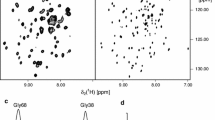Abstract
Integral membrane proteins are important but challenging research subjects. Various membrane mimetics have been developed that should preserve the native structure and function of membrane proteins while rendering them amenable to biophysical, biochemical, and structural investigations. Here, we summarize recent progress with fluorinated surfactants and amphiphilic copolymers, two unconventional membrane mimetics that possess considerable advantages over canonical detergents or lipid vesicles.
Similar content being viewed by others
Literatur
Bordag N, Keller S (2010) a-helical transmembrane peptides: a “divide and conquer” approach to membrane proteins. Chem Phys Lipids 163:1–26
Jamshad M, Lin YP, Knowles TJ et al. (2011) Surfactantfree purification of membrane proteins with intact native membrane environment. Biochem Soc Trans 39:813–818
Durand G, Abla M, Ebel C et al. (2014) New amphiphiles to handle membrane proteins: “ménage à trois” between chemistry, physical chemistry, and biochemistry. In: Mus-Veteau I (Hrsg) Membrane Proteins Production for Structural Analysis. Springer, Heidelberg, 205–251
Abla M, Unger S, Keller S et al. (2015) Micellar and biochemical properties of a propyl-ended fluorinated surfactant designed for membrane-protein study. J Colloids Interface Sci 445:127–136
Frotscher E, Danielczak B, Vargas C et al. (2015) A fluorinated detergent for membrane-protein applications. Angew Chem Int Ed 54:5069–5073
Vargas C, Cuevas Arenas R, Frotscher E et al. (2015) Nanoparticle self-assembly in mixtures of phospholipids with styrene/maleic acid copolymers or fluorinated surfactants. Nanoscale 7:20685–20696
Herrmann M, Danielczak B, Textor M et al. (2015) Modulating bilayer mechanical properties to promote the coupled folding and insertion of an integral membrane protein. Eur Biophys J 44:503–512
Knowles TJ, Finka R, Smith C et al. (2009) Membrane proteins solubilized intact in lipid containing nanoparticles bounded by styrene maleic acid copolymer. J Am Chem Soc 131:7484–7485
Orwick MC, Judge PJ, Procek J et al. (2012) Detergent-free formation and physicochemical characterization of nanosized lipid–polymer complexes: Lipodisq. Angew Chem Int Ed 51:4653–4657
Dörr JM, Koorengevel MC, Schäfer M et al. (2014) Detergent-free isolation, characterization, and functional reconstitution of a tetrameric K+ channel: the power of native nanodiscs. Proc Natl Acad Sci USA 111:18607–18612
Author information
Authors and Affiliations
Corresponding author
Additional information
Sandro Keller, Erik Frotscher, Carolyn Vargas, Rodrigo Cuevas Arenas und Anne Grethen (v. l. n. r.)
Carolyn Vargas Jahrgang 1974. Chemiestudium an der University of the Philippines Diliman. 2003–2008 wissenschaftliche Mitarbeiterin am Leibniz-Institut für Molekulare Pharmakologie (FMP) Berlin und 2008–2009 bei Evotec AG. 2009 Promotion an der Universität Halle-Wittenberg. Seit 2010 wissenschaftliche Mitarbeiterin in der Abteilung Molekulare Biophysik an der TU Kaiserslautern.
Erik Frotscher Jahrgang 1988. Biologiestudium an der TU Kaiserslautern, dort seit 2014 Promotion in der Abteilung Molekulare Bio physik.
Rodrigo Cuevas Arenas Jahrgang 1985. Biologiestudium an der Pontificia Universidad Católica de Chile und an der TU Kaiserslautern. Seit 2014 Promotion in der Abteilung Molekulare Biophysik an der TU Kaiserslautern.
Anne Grethen Jahrgang 1989. Biophysikstudium an der TU Kaiserslautern, dort seit 2016 Promotion in der Abteilung Molekulare Bio physik.
Sandro Keller Jahrgang 1978. Studium am Biozentrum der Universität Basel, Schweiz, mit Spezialisierung in Biophysikalischer Chemie. 2006 Promotion an der Universität Halle-Wittenberg. 2006–2009 Nachwuchsgruppenleiter am Leibniz-Institut für Molekulare Pharmakologie (FMP) Berlin. 2009–2015 Juniorprofessor und seit 2015 Professor für Molekulare Biophysik an der TU Kaiserslautern.
Rights and permissions
About this article
Cite this article
Vargas, C., Frotscher, E., Cuevas Arenas, R. et al. Fluorierte Tenside und native Nano discs für die Membranproteinforschung. Biospektrum 22, 140–142 (2016). https://doi.org/10.1007/s12268-016-0667-2
Published:
Issue Date:
DOI: https://doi.org/10.1007/s12268-016-0667-2




